Black/African American History in Fort Collins#
Want to Explore Places in the Black History of Fort Collins? Try this Virtual Tour!
Explore sites that tell the story of Black/African American residents of Fort Collins.
Most of these sites are privately-owned. Please respect private property and all directions and postings from owners. Download the brochure and visit the sites from the public right of way, whether on foot, by bicycle, or in your car, or explore the sites virtually from home.
You've heard the familiar stories about Fort Collins but much of our community's history, specifically the narratives of historically marginalized groups, has often been overlooked. Join us as we explore the full stories of Fort Collins past—in this first edition video, we follow the early experiences of Black settlers in Fort Collins, as well as community leaders and organizations who made the necessary push for civil rights. The Full Story Fort Collins project is a collaboration between the City’s Communications & Public Involvement Office and Historic Preservation Services.
The Negro’s past can never be forgotten; his present is being carefully observed, and his future is yet to be made.
– Charles Birdwhistle, former African American resident of Fort Collins, 1899
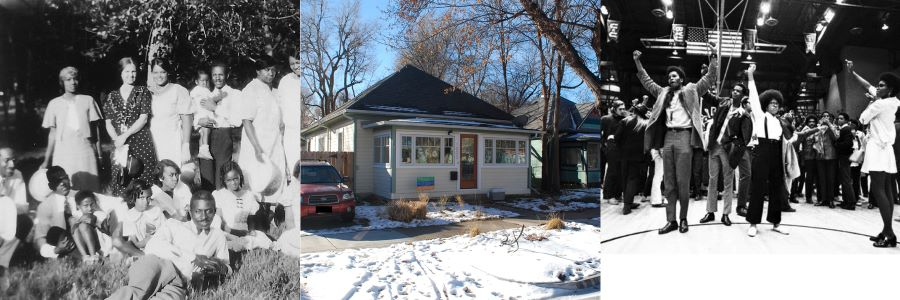
Left: William & Joyce Lyle with others, possibly at Washington Park, c.1935, (courtesy of the Starr & Lyle Family, www.starrlyle.com); Birdwhistle residence at 1005 W. Oak Street, 2021; Students protesting during the BYU-CSU men's basketball game at Moby Arena on February 5, 1970, (Alumni Photograph Collection, Colorado State University Libraries, Archives & Special Collections).
Black/African Americans in Colorado#
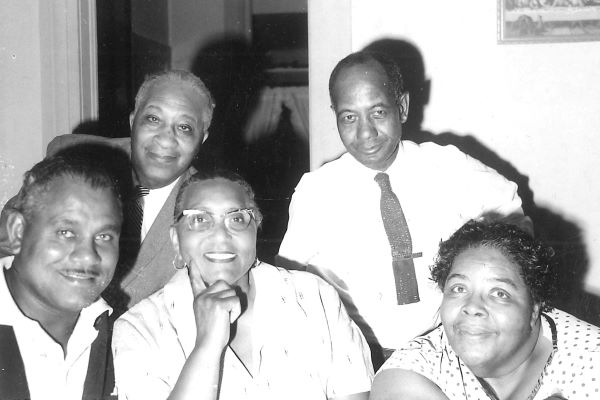
William and Mattie Lyle (center) with friends Claude & Sedalia Murray (right) and Charles Cousins (left) in Denver, courtesy of the Starr & Lyle Family, www.starrlyle.com.
Black/African American history has deep roots in the American West. Early Spanish expeditions and American territorial expansion in the 19th century brought both enslaved and free people of African descent into what are now the western states. From the enslaved explorer York who accompanied William Clark on the Lewis & Clark expedition in 1803, to civic leaders and activists of the 20th century, such as Denver resident Dr. Joseph Westbrook, the West held challenges and opportunities for Black/African Americans that were both typical and unique within the tapestry of American history. Throughout the history of the colonization of North America, Black people have exemplified resilience in the face of persistent attempts to marginalize their communities. Their story is one of continued perseverance, community-building, and resistance against systemic racism—a theme that is reflected in Black history across the United States, including western cities such as Fort Collins.
Black migration to the American West accelerated significantly in the 20th century as individuals and families sought opportunities for self-determination beyond the Jim Crow South. In many western communities, Black families found greater freedom in urban and rural enclaves where families joined early Black pioneers and established a shared sense of community and protection. In Black farming colonies such as Nicodemus, Kansas, and Dearfield, Colorado, and in urban neighborhoods established in bigger cities such as Topeka, Kansas City, and Denver, Black Americans left Southern states to form new communities that afforded more freedom and good-paying jobs. However, they were still subject to the nation’s widespread racism. They also established neighborhoods in smaller towns and cities such as Fort Collins in response to labor demands in mining, beet sugar production, the service industries, and other job sectors. In every aspect of life in the American West, from the military to business to religious worship to community activism, Black Americans faced endemic racism but continued to fight for and win respect for their labor, their professional expertise, their influential talent, and their contributions to American culture and society.
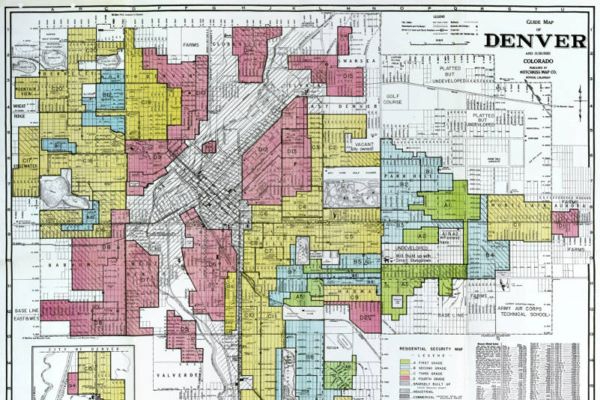
Map of redlined neighborhoods, including Five Points near the center. Courtesy of Denver Public Library, Western History & Genealogy.
While western states like Colorado often provided the prospect of opportunity for Black families, the racism that plagued most of the nation remained a persistent barrier. While there were fewer than 500 African Americans in Colorado in 1870, the territory failed to achieve statehood until 1876 largely because the white, male electorate initially refused to support the continuance of Black male suffrage—a condition of statehood required by the Reconstruction-era Congress. Through the efforts of Black leaders, including many women such as Elizabeth Piper Ansley, the Black community in Colorado continued to grow and prosper, particularly in Denver’s Five Points neighborhood. Homes, churches, and Black fraternal and social clubs were important places for building community and organizing for progress in the public sphere, such as school integration and the passage of a civil rights bill in 1885.
Black newspapers in Denver celebrated professional and educational achievements, entertainment, the state’s many all-Black baseball teams, and the social activities of Black residents in every town, as well as providing vital information neglected in local newspapers about discrimination around the state. Black professionals and business owners grew in number, as did the middle class made up of barbers, waiters, and porters. Some members of Colorado’s white citizenry continuously challenged this progress. The Ku Klux Klan, America’s most notorious white supremacist organization, had strong membership in Colorado during the early 1900s and sponsored recruitment rallies and other public events from Denver to Fort Collins, which set the stage for Klan member Clarence Morley’s election as Governor of Colorado from 1925 to 1927.
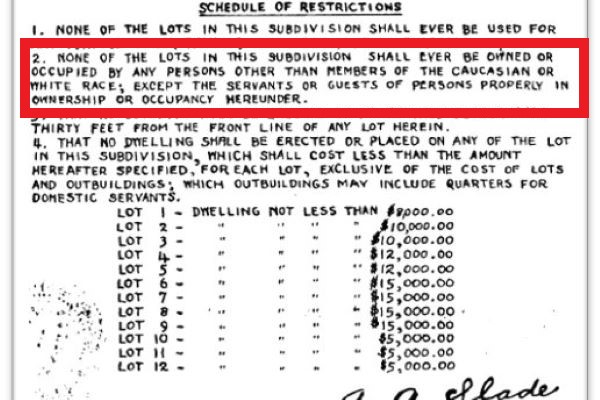
Plat map schedule of restrictions for Slade Acres, a small neighborhood south of City Park in Fort Collins platted in 1948, noting a covenant barring any but white individuals from owning property in the neighborhood. Subdivision Plat Maps, City of Fort Collins.
While the overt power of the Klan and other white supremacist organizations to control the levers of government declined in later years, discriminatory and racist practices endemic to American society continued. White property owners and landlords frequently discriminated against Black residents well into the 1960s through restrictive racial covenants that prevented purchase of property in many neighborhoods, and refusing to rent to Black tenants. The problem was compounded by “redlining” neighborhoods to limit mortgage lending in Black areas of cities. Both practices perpetuated racial segregation and the generational wealth gaps found today between Black and white Americans. Racism in the legal system also protected strict boundaries of racial identity in Colorado, including an anti-miscegenation law on the books until 1957 (a law prohibiting mixed-race marriages). After the Second World War, the Colorado legislature passed a series of Civil Rights reforms including a 1948 ban on racially restrictive housing covenants, a 1951 act prohibiting racial discrimination in public employment, and a fair housing law in 1959. Although these laws were passed, their lackluster enforcement and implementation remained a key civil rights issue into the 1970s. Later U.S. Supreme Court case outlawed private-sector employment discrimination in Colorado in 1963 and forced an end to segregation in Denver Public Schools in 1973. Activism by Black-led organizations like the NAACP and the Black Panthers continued to fight for expanded equality and equity.
The legacy of this discrimination remains alongside the individual stories of success. Because Black lives were often forced to the margins, our official historical record frequently obscures their stories and the places associated with their lives. As a result, Black historic sites are far less recognized than the sites associated with the white community, and in many cases, have been lost to redevelopment and urban renewal projects. Below, we explore this legacy in Fort Collins.
Pioneering Black Families in Fort Collins#
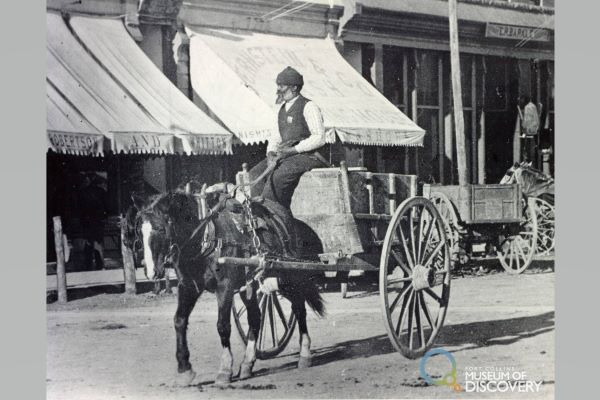
Charles H. Clay in Fort Collins. (H00046). Courtesy of the Fort Collins Museum of Discovery.
Like many smaller western communities, Fort Collins was home to a small but vibrant Black community from its early days. Census and newspaper records mention several Black residents, mostly making a living as janitors, domestic workers, or porters for the railroads, hotels, and other businesses. The 1880 census documents fifteen Black residents in five households in and around downtown Fort Collins, most notably the Burnsides family. Isaac and Lettie Burnsides had moved their household from Arkansas to Kansas before coming to Colorado, a common westward trajectory for Fort Collins’ Black families. By 1900, Fort Collins’ Black population remained small, with only sixteen residents noted in the census, including five households and three live-in servants. However, these numbers are artificially low, as many residents were missed in censes and directories because they were not here long enough or simply were not recognized in official records. For example, in its first few years of operation the Great Western Sugar plant appears to have employed Black laborers who lived just west of the factory, but we have not yet determined the location of the workers’ housing and they do not appear in city directories or census records.
Despite its small size, the Black community in Fort Collins reflected the same optimism for growth and more permanent security that was found in the city as a whole. Society column entries in Denver’s Black newspapers reflect a social network along the Front Range that was interdependent, mobile, and growing. Fort Collins included several families who were part of that network and committed to expanding their collective presence in northern Colorado. The Clay family was among the most prominent, long-standing of these families in early Fort Collins. Charley Clay arrived in Colorado in 1864 as a cook accompanying a military detachment sent to the Overland stage station at Fort Latham several miles southeast of Greeley. He arrived in Laporte the following year, where he found work as a barber and cook. Although not appearing in the 1880 census, Clay was well-known in the Fort Collins area by 1882 as a caterer and cook. Charles and his wife, Anna, had seven children. The Clay home at 317 Maple, believed to have been located along a mid-block alley west of Washington Park, was the center of Black social life in Larimer County during the early 1900s. Out of his home, Charley Clay ran the Colored Mission, which became the Zion Baptist Church, and ministered to Black families throughout the region. His son, Charles Clay, Jr., established a home just to the north at 321 Maple. The Clays hosted visitors and entertainers and meetings and important social gatherings, such as the local chapter of the Paul Laurence Dunbar Literary Society, a national organization named for the famous Black poet that discussed contemporary social and political issues.3 In his later years, Charley, Sr. worked for the city as the “scavenger,” removing disposed items and trash that accumulated on public streets due to lack of waste removal services. Most of the large Clay family had dispersed to other communities or had passed away by the time the family patriarch was laid to rest in Grandview Cemetery in 1910. Charles Jr.’s wife, Nellie Clay, was the last family member on record living at 321 Maple. She lived in the home in 1919 while working as a janitor at the Empress and Lyric Theaters, but by 1920, she had moved away.
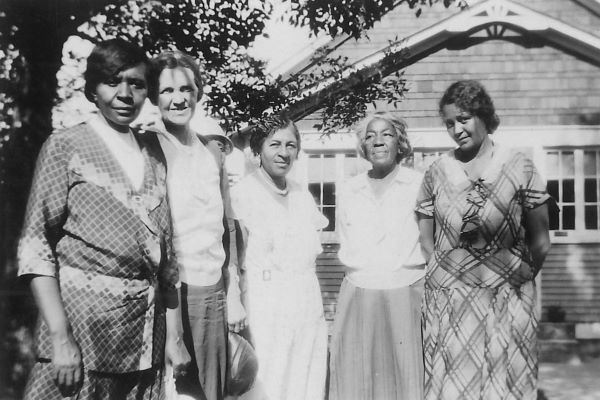
Martha Lyle, center, with unidentified friends or neighbors in front of 312 N Meldrum, circa 1935. Photo courtesy of the Starr & Lyle Family, www.starrlyle.com.
During this same period, other Black families put down roots in north Fort Collins. Black families like the Hicks, Lyles, McDaniels, Murrays, and Thomas’ moved into homes near the intersection of Maple and Meldrum Streets in the early 1900s. Harkless and Hattie Hicks were living in the residence at 310 N. Meldrum Street by 1900. They moved next door to 312 N. Meldrum in 1919 and remained at that location through 1933, with Harkless working as a janitor at various businesses around town. William and Mattie Lyle of Kansas moved into 310 N. Meldrum, and William’s mother, Martha Lyle, lived with Harkless and worked as his housekeeper. The Lyles moved into 312 N. Meldrum after Hicks passed away. Educated at the Kansas State Normal School (now Emporia State University), the Lyles remained in Fort Collins into the 1940s, with William working as a janitor at various local businesses including the Poudre Valley National Bank at 103 W. Mountain Avenue. Mattie Lyle made local civil rights history in 1939 when she successfully sued the owner of the State Theater on North College for discrimination in Larimer County Court.
Although they only lived in Fort Collins for a very short time, the McDaniels are the most widely known Black family in early Fort Collins history. Henry and Susan McDaniel moved with their children from Wichita to Denver, and for a brief time just after the turn of the 20th century the family lived in Fort Collins at 317 Cherry Street while Henry worked locally as a teamster. Henry and Susan were gospel singers, he was also an itinerant Baptist preacher, and several of their children grew up to be talented performers. While they lived on Cherry Street, their young daughter, Hattie McDaniel, attended the Franklin School at Howes & Mountain. Hattie is most remembered for being the first Black American to win an Academy Award, for her 1939 role in Gone with the Wind. She is also recognized for her civil rights activism as a participant in the groundbreaking 1945 “Sugar Hill” lawsuit that ended restrictive racial covenants in her Los Angeles neighborhood.
Other Black families moved into homes farther west, such as the Goodalls and Birdwhistles. By 1909, Andrew and Edith Goodall, and their son James were living at 131 [North] Mack Street. Edith Goodall became active in the local chapter of the Woman’s Christian Temperance Union, a key women’s suffrage organization, and hosted a chapter meeting in their parlor. The Goodalls eventually left Fort Collins to join the pioneer Weld County community of Dearfield, a Black-owned agricultural colony. Some families, like the Clays, found opportunity in smaller communities, while others, like the McDaniels, found the larger Black community in Denver, or the exclusively Black community of Dearfield, to be more attractive for their family’s future. In several cases, despite the limitations of segregation and racism, these local families were able to invest in real estate, purchase automobiles to increase their independent mobility, and provide educational and social opportunities for their children that served their ambitions to build financial security and professional success. to be more attractive for their family’s future.
Despite these opportunities, one of the key challenges faced by Black Americans who were newcomers to the West, or simply visiting, was identifying and negotiating the boundaries of informal and legalized segregation, economic discrimination, and racism. Some Black families, such as Charlie and Mamie Birdwhistle, helped navigate those boundaries by providing advocacy and safe places to lodge and visit. The Birdwhistles also moved into west Fort Collins on Oak Street and used their residence to provide social gatherings and church services for the Black community as well as a place for travelers to stay when visiting Larimer County. Although never listed in the Negro Motorist Green Book, records show the Birdwhistles regularly hosted musicians who came to the city to entertain local white audiences but were not welcome in local hotels. Charlie Birdwhistle was also a respected pastor of the African Methodist Episcopal (AME) Church, but the community was unable to amass enough resources and momentum to overcome the barriers to creating a permanent church location in Fort Collins. Without this important central feature of the Black community, it was more difficult for that community to grow. At the same time, white supremacist organizations like the Klan continued activities in Fort Collins, including rallies at the America Theater on North College Avenue, participation in Colorado Agricultural College events, and a cross-burning in City Park in 1925. With limited employment opportunities, few options for religious worship, and still-rampant racism, many families like the Lyles moved to urban areas by the 1940s for better jobs, larger church congregations, and safer neighborhoods.
Black Life at the University#
One of the primary draws for many Black Americans who moved to Fort Collins was a college education. However, because discrimination in northern Colorado remained high, only a few Black students attended Colorado Agricultural College (CAC) in its early years. The first known of these was among the first Black Americans to attend a land grant institution anywhere in the American West: Grafton St. Clair Norman. CAC President Alston Ellis, a former education administrator in Ohio who had successfully desegregated schools in Hamilton, Ohio in 1891, personally recruited Norman to attend CAC in 1892. Norman was only sixteen at the time and was likely drawn by the prospect of a familiar face in Ellis and the opportunity of a college education. His decision may also have been influenced by the recent lynching of a Black man in Oxford, Ohio that year, fifteen miles from Hamilton. Norman was an extremely involved student beyond his studies between 1892 and 1896. He participated in the YMCA, the Columbian Literary Society, the Glee Club, College Choir, the Science Club, and was a quartermaster sergeant for the College’s battalion, the precursor to its ROTC training program. He was unanimously elected by the student body to be the College orator for the celebration of Washington’s Birthday in 1896. Norman went on to serve in the U.S. Army in the Spanish-American War and First World War. During peace time, he was a teacher, instructing in math and science at colleges in Alabama before becoming an insurance administrator. He was killed by a driver while exiting a streetcar in Birmingham, Alabama, in 1945.
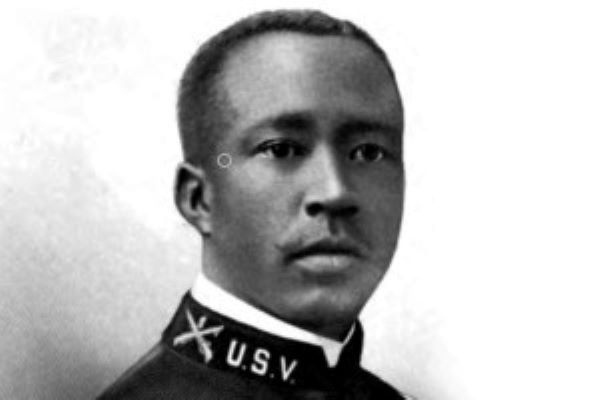
Grafton St. Clair Norman. Courtesy of Colorado State University.
Norman paved the way for other Black students to follow at CAC. In 1914, Maceo Spratlin of Denver and Ms. Helen Dobbs of Evergreen are believed to be the first Black students to enroll at the College since Norman attended in the 1890s. Dobbs, who enrolled in the School of Agriculture, may have been the first Black woman to attend CAC. Spratlin enrolled in the veterinary program, likely being the first Black student to do so in the history of the College. Norman, Spratlin, and Dobbs were part of what became a small but notable lineage of Black students at CAC that sought to use education to unlock better economic opportunity. While there, they faced racism and discrimination, including lack of available housing off-campus, discrimination from other students, and activities held by the Ku Klux Klan. Nevertheless, their presence among the CAC student body began a long tradition of Black students from Denver and beyond who, at least temporarily, become Fort Collins residents.
Fighting Discrimination#
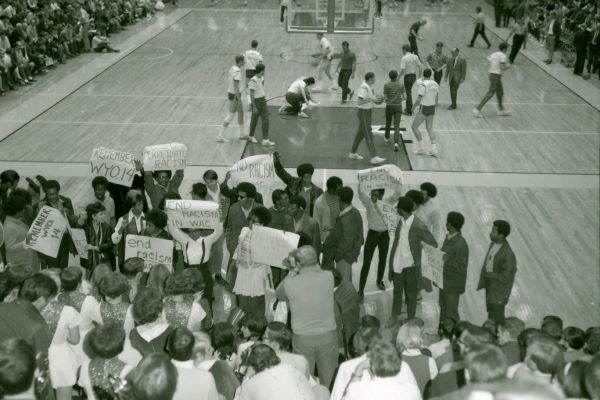
1970 Moby Arena protest against BYU. Alumni Photograph Collection, Colorado State University Libraries, Archives & Special Collections.
Colorado State University as the college was later named, continued to be an attraction for young Black people to move to Fort Collins. However, they also still faced housing discrimination into the 1970s, especially off-campus. While Fort Collins never achieved the size for the Federal Housing Authority to officially “redline” the city (a process of identifying risk to lenders based on racial demographics), discrimination and segregation in housing nonetheless occurred. Black students frequently had difficulty finding housing off-campus. Two subdivisions platted in the 1940s (Circle Drive in 1945, and Slade Acres in 1948) barred non-whites from owning or occupying property within their boundaries (although live-in domestic workers could be people of color), even though such covenants became illegal in the state in 1948.
The persistence of housing discrimination motivated students to create the Black Student Alliance (BSA). Founded by students like Paul Chambers, Trudi Morrison, and Meredith Springs in 1968, the BSA allied itself with the Mexican American Committee for Equality (MACE) and began pressuring the University administration to improve conditions. This included combatting housing discrimination off-campus, but also recruiting more Black students, administrators, and faculty, to help make the university more representative of the state community it served. This pressure included protests and sit-ins, including demonstrations on the lawn of CSU President William Morgan’s residence at 645 S. Shields Street on April 9, 1969, and demonstrations at the Lory Student Center and Old Main administrative building that month. The climax of demonstrations came in 1970 when students led by the BSA protested the CSU-BYU basketball game in Moby Arena over the exclusion of Black Americans from the clergy of the Church of Jesus Christ of Latter Day Saints (LDS, or Mormons). Many students held signs referencing solidarity with the Wyoming Fourteen, fourteen Black members of the Wyoming Cowboys football team dismissed by head coach Lloyd Eaton for requesting to wear black armbands in protest of BYU at their scheduled 1969 game. The protests met with mixed success; the University began working on student demands focused on improved student recruitment, university hiring, and exposure of all students to Black history and culture. These efforts resulted in the establishment of ethnic studies programs at the University, and the creation of the Black Student Union, now known as the Black/African American Cultural Center. However, student and employee recruitment remained a persistent problem.
We Need Your Help!
Our goal is to recognize the important places in Fort Collins that reflect the full history of our Black community, as an important but underrepresented group in our city’s widely recognized history to date. If you have stories, photographs, or research leads that will help us identify important sites and people in Fort Collins associated with Black history, please contact us and help us in our effort to tell the full story of our community. Contact us at preservation@fcgov.com.
Suggested Reading and Resources#
Websites and other Sources
- History Colorado - African American Coloradans
- Black American West Museum & Heritage Center (Denver)
- Blackpast.org
- National Park Service - African American Heritage
- National Park Service - African American Homesteaders in the Great Plains
- Fort Collins Museum of Discovery Archives and History Connection
- Colorado State University - Black/African American Cultural Center
Books
- Quintard Taylor, America I AM Black Facts and In Search of the Racial Frontier: African Americans in the American West, 1528-1990
- Albert Broussard, Expectations of Equality: A History of Black Westerners
- Isabel Wilkerson, The Warmth of Other Suns and Caste: The Origins of Our Discontents
- Richard Rothstein, The Color of Law: A Forgotten History of How Our Government Segregated America
- Bruce A. Glasrud and Cary D. Wintz, eds., Black Americans and the Civil Rights Movement in the West
Special thanks from the Historic Preservation Services division for the research support of David North, Rebekah Schields, Ben Warner, and Lesley Struc.
Click below to learn more about a wide variety of Fort Collins history topics developed by Historic Preservation Services.
